Comprehensive Report on Quality and Risk Management in Healthcare
VerifiedAdded on 2023/04/26
|22
|4906
|395
Report
AI Summary
This report delves into the critical aspects of quality and risk management within the healthcare sector. It addresses the evolving awareness of quality among the public, emphasizing how patients are now more informed and engaged in their healthcare decisions. The report outlines key principles essential for promoting quality of care, including focusing on improved patient care, supporting the physician-patient relationship, using evidence-based clinical guidelines, and utilizing reliable data. It also examines respondents' perceptions of redress mechanisms available to them in cases of harm, highlighting variations across different countries. The analysis underscores the importance of quality improvement projects, the role of organizations like NCQA and TJC, and the implementation of methods such as ISO and Six Sigma to enhance healthcare quality. The document, contributed by a student, is available on Desklib, offering valuable insights and resources for students studying healthcare management.
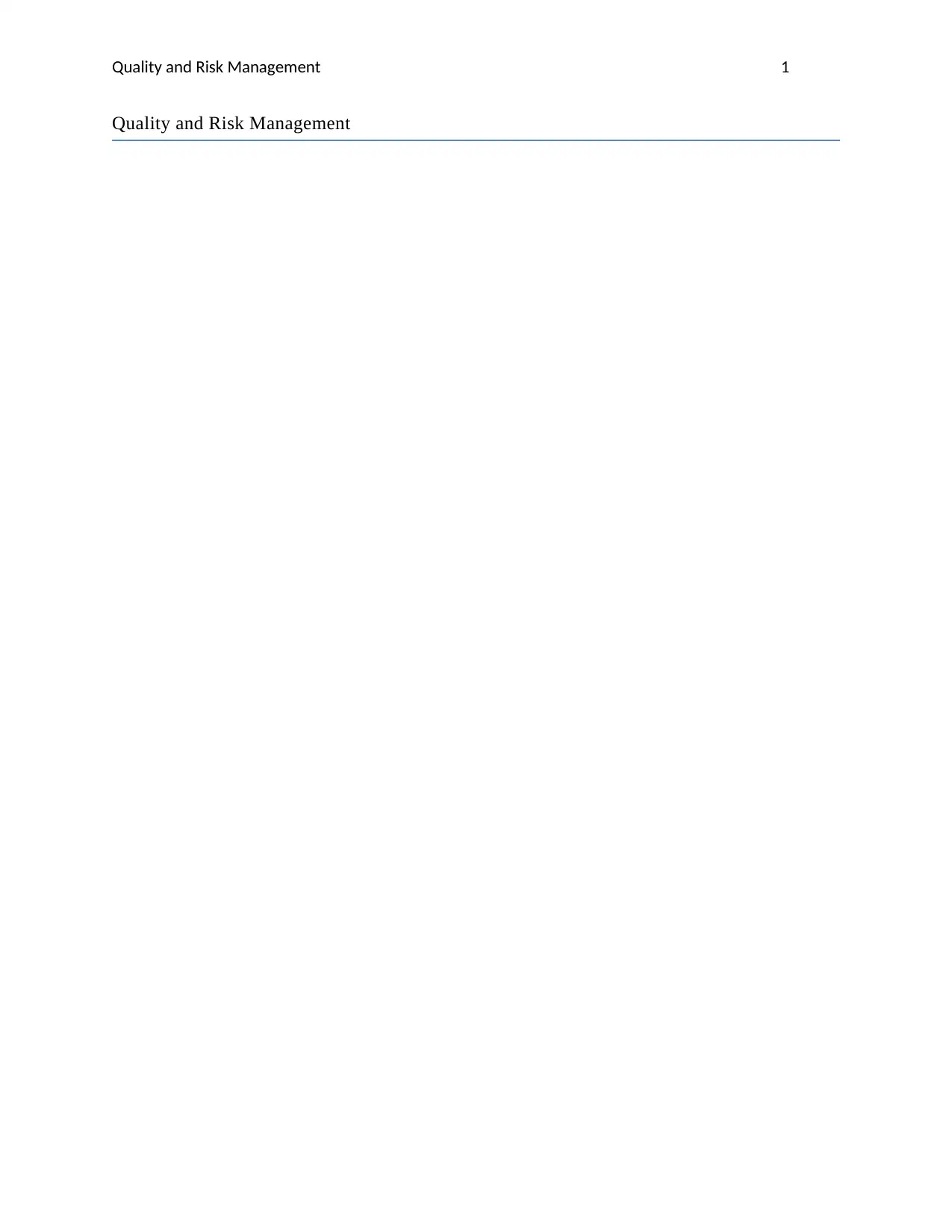
Quality and Risk Management 1
Quality and Risk Management
Quality and Risk Management
Paraphrase This Document
Need a fresh take? Get an instant paraphrase of this document with our AI Paraphraser
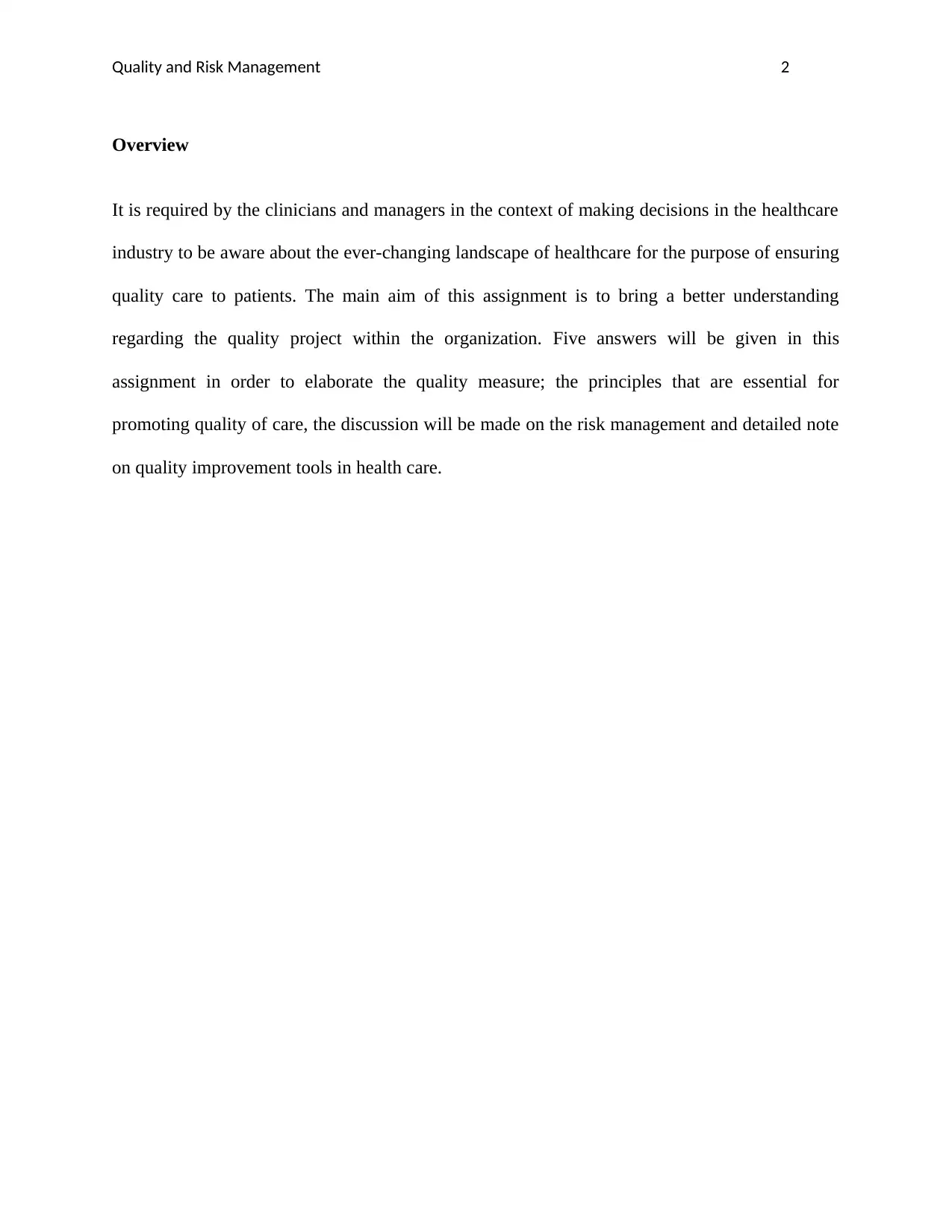
Quality and Risk Management 2
Overview
It is required by the clinicians and managers in the context of making decisions in the healthcare
industry to be aware about the ever-changing landscape of healthcare for the purpose of ensuring
quality care to patients. The main aim of this assignment is to bring a better understanding
regarding the quality project within the organization. Five answers will be given in this
assignment in order to elaborate the quality measure; the principles that are essential for
promoting quality of care, the discussion will be made on the risk management and detailed note
on quality improvement tools in health care.
Overview
It is required by the clinicians and managers in the context of making decisions in the healthcare
industry to be aware about the ever-changing landscape of healthcare for the purpose of ensuring
quality care to patients. The main aim of this assignment is to bring a better understanding
regarding the quality project within the organization. Five answers will be given in this
assignment in order to elaborate the quality measure; the principles that are essential for
promoting quality of care, the discussion will be made on the risk management and detailed note
on quality improvement tools in health care.
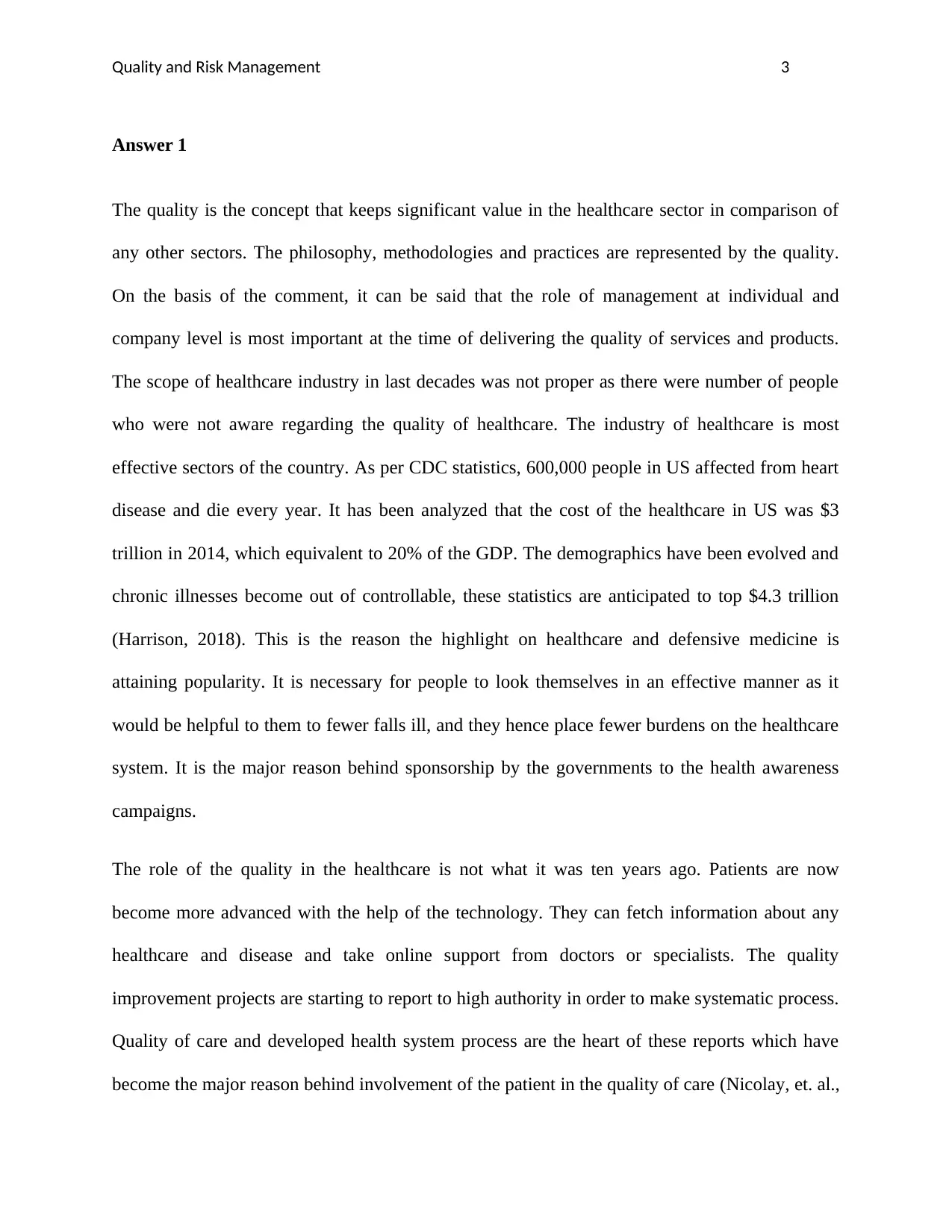
Quality and Risk Management 3
Answer 1
The quality is the concept that keeps significant value in the healthcare sector in comparison of
any other sectors. The philosophy, methodologies and practices are represented by the quality.
On the basis of the comment, it can be said that the role of management at individual and
company level is most important at the time of delivering the quality of services and products.
The scope of healthcare industry in last decades was not proper as there were number of people
who were not aware regarding the quality of healthcare. The industry of healthcare is most
effective sectors of the country. As per CDC statistics, 600,000 people in US affected from heart
disease and die every year. It has been analyzed that the cost of the healthcare in US was $3
trillion in 2014, which equivalent to 20% of the GDP. The demographics have been evolved and
chronic illnesses become out of controllable, these statistics are anticipated to top $4.3 trillion
(Harrison, 2018). This is the reason the highlight on healthcare and defensive medicine is
attaining popularity. It is necessary for people to look themselves in an effective manner as it
would be helpful to them to fewer falls ill, and they hence place fewer burdens on the healthcare
system. It is the major reason behind sponsorship by the governments to the health awareness
campaigns.
The role of the quality in the healthcare is not what it was ten years ago. Patients are now
become more advanced with the help of the technology. They can fetch information about any
healthcare and disease and take online support from doctors or specialists. The quality
improvement projects are starting to report to high authority in order to make systematic process.
Quality of care and developed health system process are the heart of these reports which have
become the major reason behind involvement of the patient in the quality of care (Nicolay, et. al.,
Answer 1
The quality is the concept that keeps significant value in the healthcare sector in comparison of
any other sectors. The philosophy, methodologies and practices are represented by the quality.
On the basis of the comment, it can be said that the role of management at individual and
company level is most important at the time of delivering the quality of services and products.
The scope of healthcare industry in last decades was not proper as there were number of people
who were not aware regarding the quality of healthcare. The industry of healthcare is most
effective sectors of the country. As per CDC statistics, 600,000 people in US affected from heart
disease and die every year. It has been analyzed that the cost of the healthcare in US was $3
trillion in 2014, which equivalent to 20% of the GDP. The demographics have been evolved and
chronic illnesses become out of controllable, these statistics are anticipated to top $4.3 trillion
(Harrison, 2018). This is the reason the highlight on healthcare and defensive medicine is
attaining popularity. It is necessary for people to look themselves in an effective manner as it
would be helpful to them to fewer falls ill, and they hence place fewer burdens on the healthcare
system. It is the major reason behind sponsorship by the governments to the health awareness
campaigns.
The role of the quality in the healthcare is not what it was ten years ago. Patients are now
become more advanced with the help of the technology. They can fetch information about any
healthcare and disease and take online support from doctors or specialists. The quality
improvement projects are starting to report to high authority in order to make systematic process.
Quality of care and developed health system process are the heart of these reports which have
become the major reason behind involvement of the patient in the quality of care (Nicolay, et. al.,
⊘ This is a preview!⊘
Do you want full access?
Subscribe today to unlock all pages.

Trusted by 1+ million students worldwide
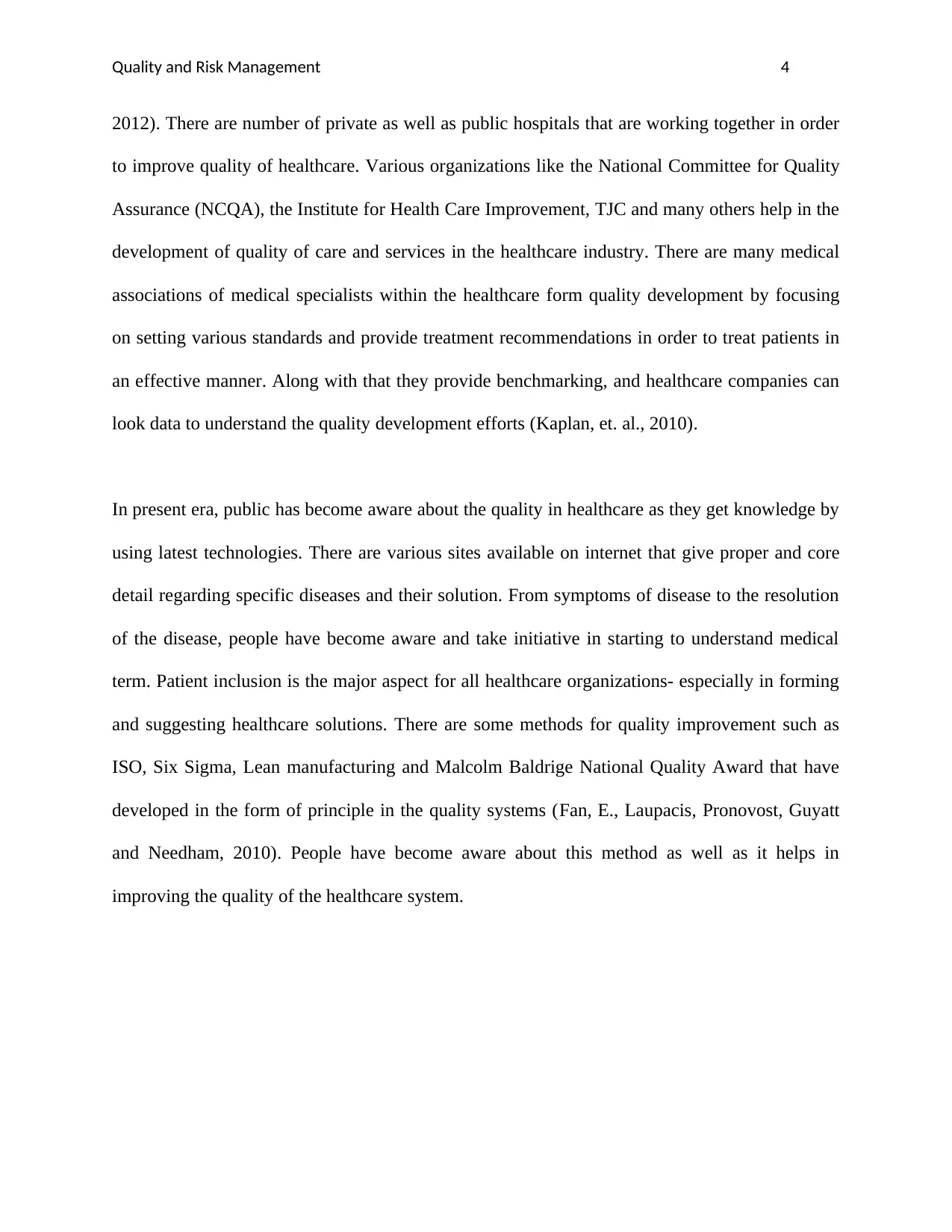
Quality and Risk Management 4
2012). There are number of private as well as public hospitals that are working together in order
to improve quality of healthcare. Various organizations like the National Committee for Quality
Assurance (NCQA), the Institute for Health Care Improvement, TJC and many others help in the
development of quality of care and services in the healthcare industry. There are many medical
associations of medical specialists within the healthcare form quality development by focusing
on setting various standards and provide treatment recommendations in order to treat patients in
an effective manner. Along with that they provide benchmarking, and healthcare companies can
look data to understand the quality development efforts (Kaplan, et. al., 2010).
In present era, public has become aware about the quality in healthcare as they get knowledge by
using latest technologies. There are various sites available on internet that give proper and core
detail regarding specific diseases and their solution. From symptoms of disease to the resolution
of the disease, people have become aware and take initiative in starting to understand medical
term. Patient inclusion is the major aspect for all healthcare organizations- especially in forming
and suggesting healthcare solutions. There are some methods for quality improvement such as
ISO, Six Sigma, Lean manufacturing and Malcolm Baldrige National Quality Award that have
developed in the form of principle in the quality systems (Fan, E., Laupacis, Pronovost, Guyatt
and Needham, 2010). People have become aware about this method as well as it helps in
improving the quality of the healthcare system.
2012). There are number of private as well as public hospitals that are working together in order
to improve quality of healthcare. Various organizations like the National Committee for Quality
Assurance (NCQA), the Institute for Health Care Improvement, TJC and many others help in the
development of quality of care and services in the healthcare industry. There are many medical
associations of medical specialists within the healthcare form quality development by focusing
on setting various standards and provide treatment recommendations in order to treat patients in
an effective manner. Along with that they provide benchmarking, and healthcare companies can
look data to understand the quality development efforts (Kaplan, et. al., 2010).
In present era, public has become aware about the quality in healthcare as they get knowledge by
using latest technologies. There are various sites available on internet that give proper and core
detail regarding specific diseases and their solution. From symptoms of disease to the resolution
of the disease, people have become aware and take initiative in starting to understand medical
term. Patient inclusion is the major aspect for all healthcare organizations- especially in forming
and suggesting healthcare solutions. There are some methods for quality improvement such as
ISO, Six Sigma, Lean manufacturing and Malcolm Baldrige National Quality Award that have
developed in the form of principle in the quality systems (Fan, E., Laupacis, Pronovost, Guyatt
and Needham, 2010). People have become aware about this method as well as it helps in
improving the quality of the healthcare system.
Paraphrase This Document
Need a fresh take? Get an instant paraphrase of this document with our AI Paraphraser
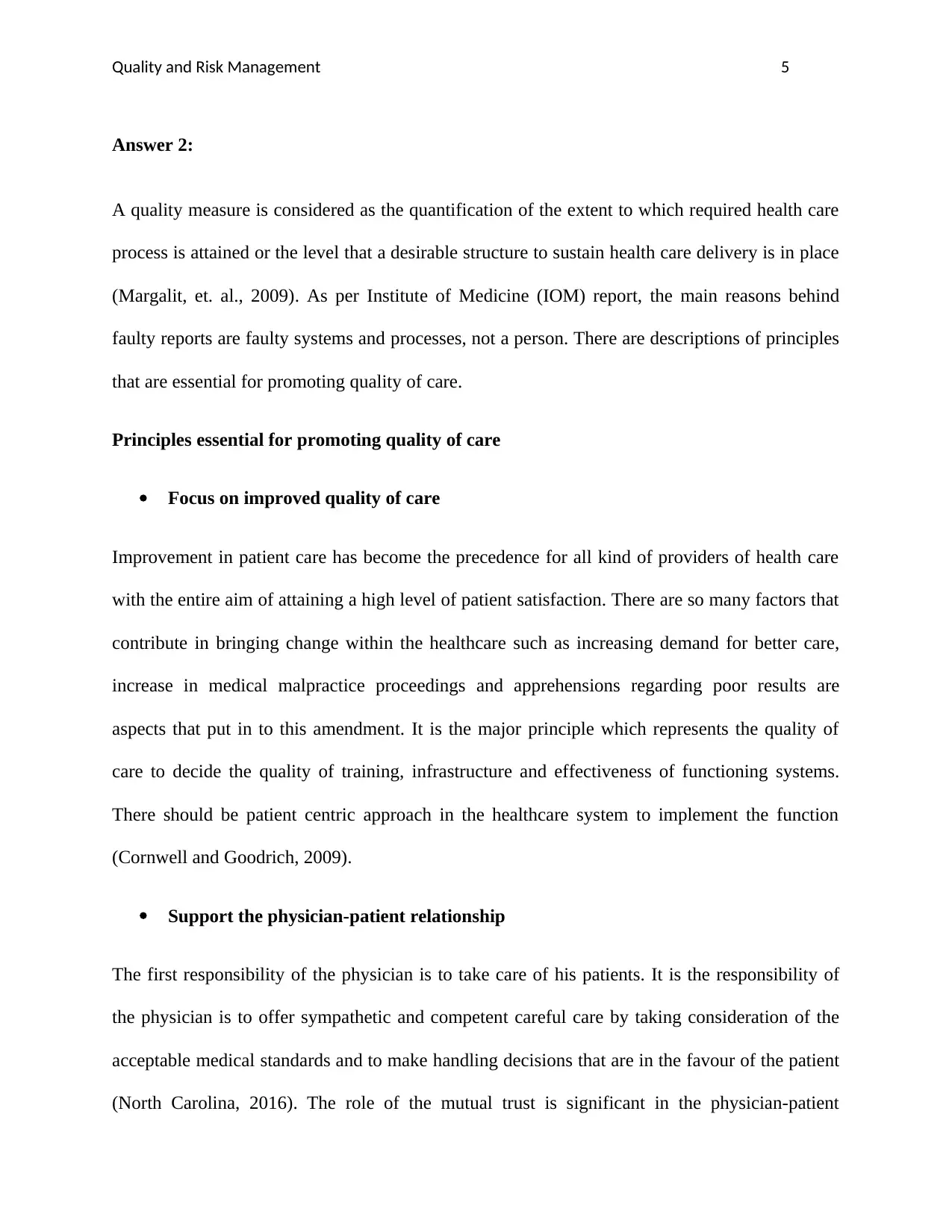
Quality and Risk Management 5
Answer 2:
A quality measure is considered as the quantification of the extent to which required health care
process is attained or the level that a desirable structure to sustain health care delivery is in place
(Margalit, et. al., 2009). As per Institute of Medicine (IOM) report, the main reasons behind
faulty reports are faulty systems and processes, not a person. There are descriptions of principles
that are essential for promoting quality of care.
Principles essential for promoting quality of care
Focus on improved quality of care
Improvement in patient care has become the precedence for all kind of providers of health care
with the entire aim of attaining a high level of patient satisfaction. There are so many factors that
contribute in bringing change within the healthcare such as increasing demand for better care,
increase in medical malpractice proceedings and apprehensions regarding poor results are
aspects that put in to this amendment. It is the major principle which represents the quality of
care to decide the quality of training, infrastructure and effectiveness of functioning systems.
There should be patient centric approach in the healthcare system to implement the function
(Cornwell and Goodrich, 2009).
Support the physician-patient relationship
The first responsibility of the physician is to take care of his patients. It is the responsibility of
the physician is to offer sympathetic and competent careful care by taking consideration of the
acceptable medical standards and to make handling decisions that are in the favour of the patient
(North Carolina, 2016). The role of the mutual trust is significant in the physician-patient
Answer 2:
A quality measure is considered as the quantification of the extent to which required health care
process is attained or the level that a desirable structure to sustain health care delivery is in place
(Margalit, et. al., 2009). As per Institute of Medicine (IOM) report, the main reasons behind
faulty reports are faulty systems and processes, not a person. There are descriptions of principles
that are essential for promoting quality of care.
Principles essential for promoting quality of care
Focus on improved quality of care
Improvement in patient care has become the precedence for all kind of providers of health care
with the entire aim of attaining a high level of patient satisfaction. There are so many factors that
contribute in bringing change within the healthcare such as increasing demand for better care,
increase in medical malpractice proceedings and apprehensions regarding poor results are
aspects that put in to this amendment. It is the major principle which represents the quality of
care to decide the quality of training, infrastructure and effectiveness of functioning systems.
There should be patient centric approach in the healthcare system to implement the function
(Cornwell and Goodrich, 2009).
Support the physician-patient relationship
The first responsibility of the physician is to take care of his patients. It is the responsibility of
the physician is to offer sympathetic and competent careful care by taking consideration of the
acceptable medical standards and to make handling decisions that are in the favour of the patient
(North Carolina, 2016). The role of the mutual trust is significant in the physician-patient
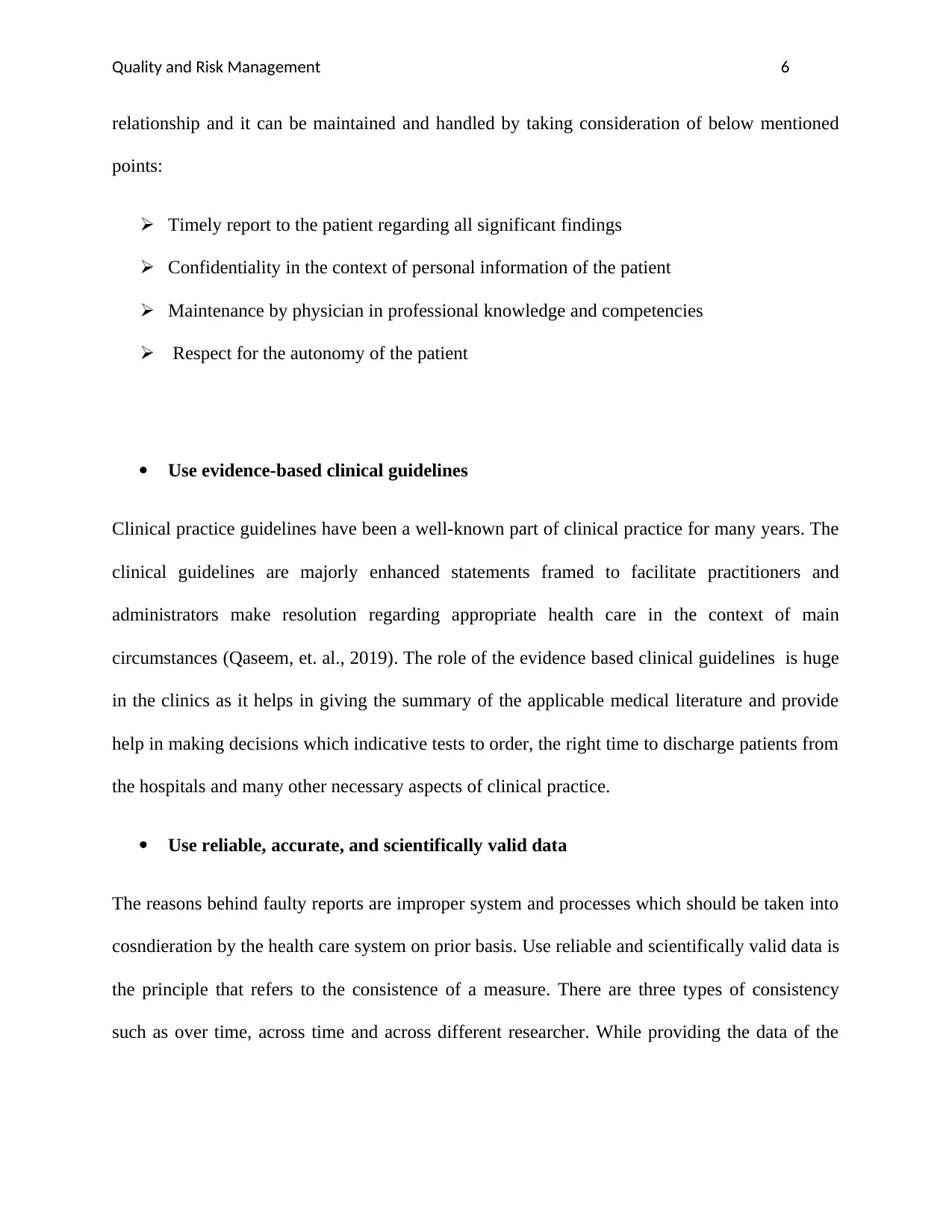
Quality and Risk Management 6
relationship and it can be maintained and handled by taking consideration of below mentioned
points:
Timely report to the patient regarding all significant findings
Confidentiality in the context of personal information of the patient
Maintenance by physician in professional knowledge and competencies
Respect for the autonomy of the patient
Use evidence-based clinical guidelines
Clinical practice guidelines have been a well-known part of clinical practice for many years. The
clinical guidelines are majorly enhanced statements framed to facilitate practitioners and
administrators make resolution regarding appropriate health care in the context of main
circumstances (Qaseem, et. al., 2019). The role of the evidence based clinical guidelines is huge
in the clinics as it helps in giving the summary of the applicable medical literature and provide
help in making decisions which indicative tests to order, the right time to discharge patients from
the hospitals and many other necessary aspects of clinical practice.
Use reliable, accurate, and scientifically valid data
The reasons behind faulty reports are improper system and processes which should be taken into
cosndieration by the health care system on prior basis. Use reliable and scientifically valid data is
the principle that refers to the consistence of a measure. There are three types of consistency
such as over time, across time and across different researcher. While providing the data of the
relationship and it can be maintained and handled by taking consideration of below mentioned
points:
Timely report to the patient regarding all significant findings
Confidentiality in the context of personal information of the patient
Maintenance by physician in professional knowledge and competencies
Respect for the autonomy of the patient
Use evidence-based clinical guidelines
Clinical practice guidelines have been a well-known part of clinical practice for many years. The
clinical guidelines are majorly enhanced statements framed to facilitate practitioners and
administrators make resolution regarding appropriate health care in the context of main
circumstances (Qaseem, et. al., 2019). The role of the evidence based clinical guidelines is huge
in the clinics as it helps in giving the summary of the applicable medical literature and provide
help in making decisions which indicative tests to order, the right time to discharge patients from
the hospitals and many other necessary aspects of clinical practice.
Use reliable, accurate, and scientifically valid data
The reasons behind faulty reports are improper system and processes which should be taken into
cosndieration by the health care system on prior basis. Use reliable and scientifically valid data is
the principle that refers to the consistence of a measure. There are three types of consistency
such as over time, across time and across different researcher. While providing the data of the
⊘ This is a preview!⊘
Do you want full access?
Subscribe today to unlock all pages.

Trusted by 1+ million students worldwide
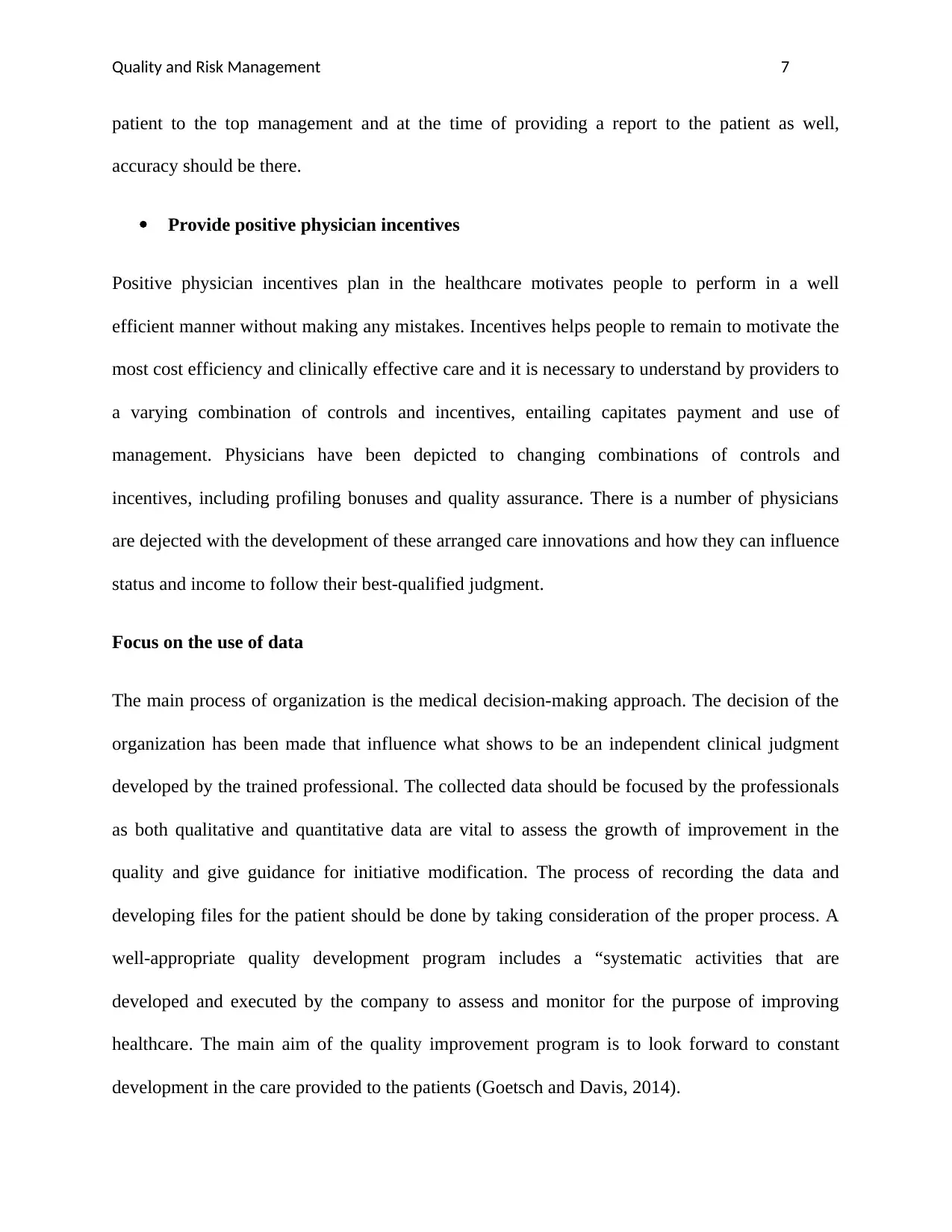
Quality and Risk Management 7
patient to the top management and at the time of providing a report to the patient as well,
accuracy should be there.
Provide positive physician incentives
Positive physician incentives plan in the healthcare motivates people to perform in a well
efficient manner without making any mistakes. Incentives helps people to remain to motivate the
most cost efficiency and clinically effective care and it is necessary to understand by providers to
a varying combination of controls and incentives, entailing capitates payment and use of
management. Physicians have been depicted to changing combinations of controls and
incentives, including profiling bonuses and quality assurance. There is a number of physicians
are dejected with the development of these arranged care innovations and how they can influence
status and income to follow their best-qualified judgment.
Focus on the use of data
The main process of organization is the medical decision-making approach. The decision of the
organization has been made that influence what shows to be an independent clinical judgment
developed by the trained professional. The collected data should be focused by the professionals
as both qualitative and quantitative data are vital to assess the growth of improvement in the
quality and give guidance for initiative modification. The process of recording the data and
developing files for the patient should be done by taking consideration of the proper process. A
well-appropriate quality development program includes a “systematic activities that are
developed and executed by the company to assess and monitor for the purpose of improving
healthcare. The main aim of the quality improvement program is to look forward to constant
development in the care provided to the patients (Goetsch and Davis, 2014).
patient to the top management and at the time of providing a report to the patient as well,
accuracy should be there.
Provide positive physician incentives
Positive physician incentives plan in the healthcare motivates people to perform in a well
efficient manner without making any mistakes. Incentives helps people to remain to motivate the
most cost efficiency and clinically effective care and it is necessary to understand by providers to
a varying combination of controls and incentives, entailing capitates payment and use of
management. Physicians have been depicted to changing combinations of controls and
incentives, including profiling bonuses and quality assurance. There is a number of physicians
are dejected with the development of these arranged care innovations and how they can influence
status and income to follow their best-qualified judgment.
Focus on the use of data
The main process of organization is the medical decision-making approach. The decision of the
organization has been made that influence what shows to be an independent clinical judgment
developed by the trained professional. The collected data should be focused by the professionals
as both qualitative and quantitative data are vital to assess the growth of improvement in the
quality and give guidance for initiative modification. The process of recording the data and
developing files for the patient should be done by taking consideration of the proper process. A
well-appropriate quality development program includes a “systematic activities that are
developed and executed by the company to assess and monitor for the purpose of improving
healthcare. The main aim of the quality improvement program is to look forward to constant
development in the care provided to the patients (Goetsch and Davis, 2014).
Paraphrase This Document
Need a fresh take? Get an instant paraphrase of this document with our AI Paraphraser
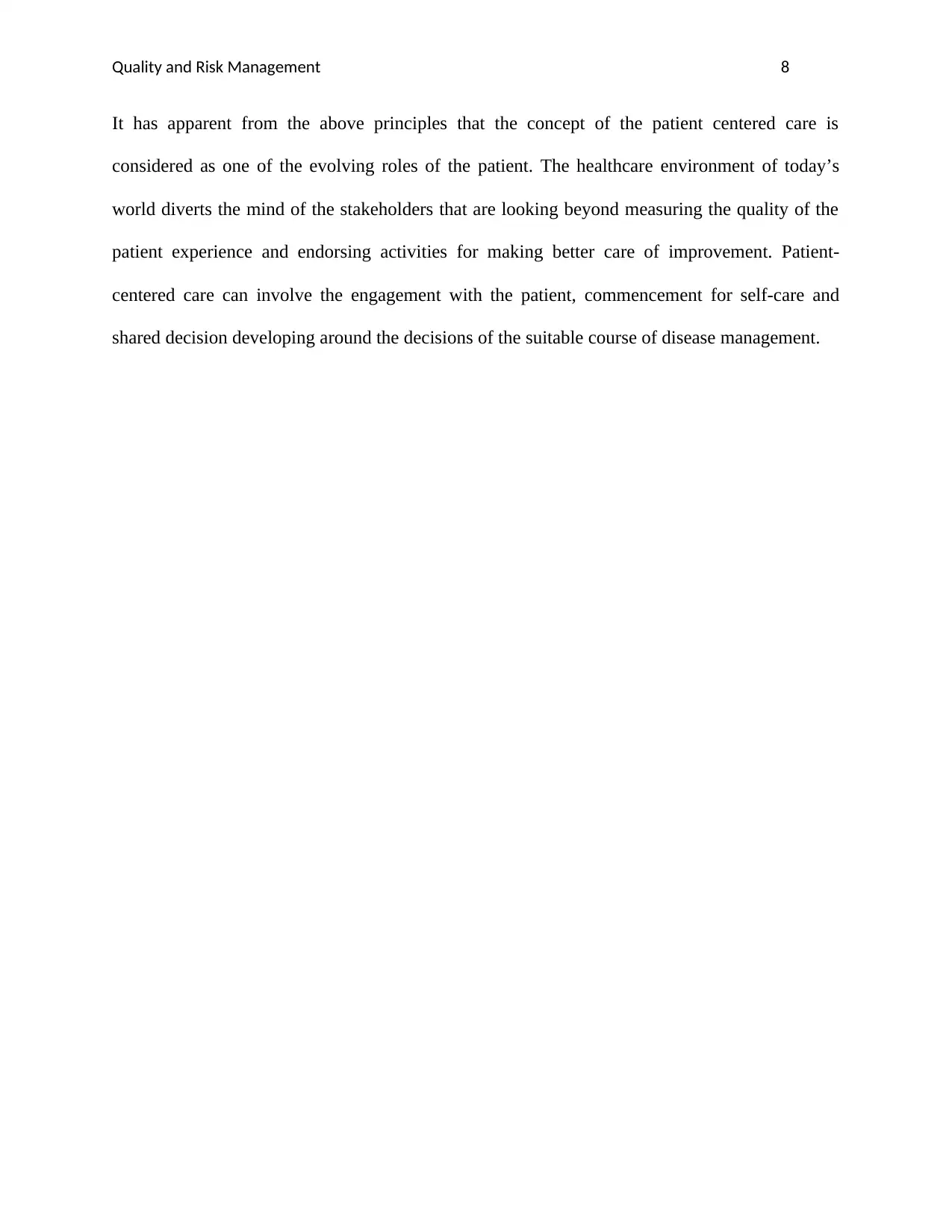
Quality and Risk Management 8
It has apparent from the above principles that the concept of the patient centered care is
considered as one of the evolving roles of the patient. The healthcare environment of today’s
world diverts the mind of the stakeholders that are looking beyond measuring the quality of the
patient experience and endorsing activities for making better care of improvement. Patient-
centered care can involve the engagement with the patient, commencement for self-care and
shared decision developing around the decisions of the suitable course of disease management.
It has apparent from the above principles that the concept of the patient centered care is
considered as one of the evolving roles of the patient. The healthcare environment of today’s
world diverts the mind of the stakeholders that are looking beyond measuring the quality of the
patient experience and endorsing activities for making better care of improvement. Patient-
centered care can involve the engagement with the patient, commencement for self-care and
shared decision developing around the decisions of the suitable course of disease management.
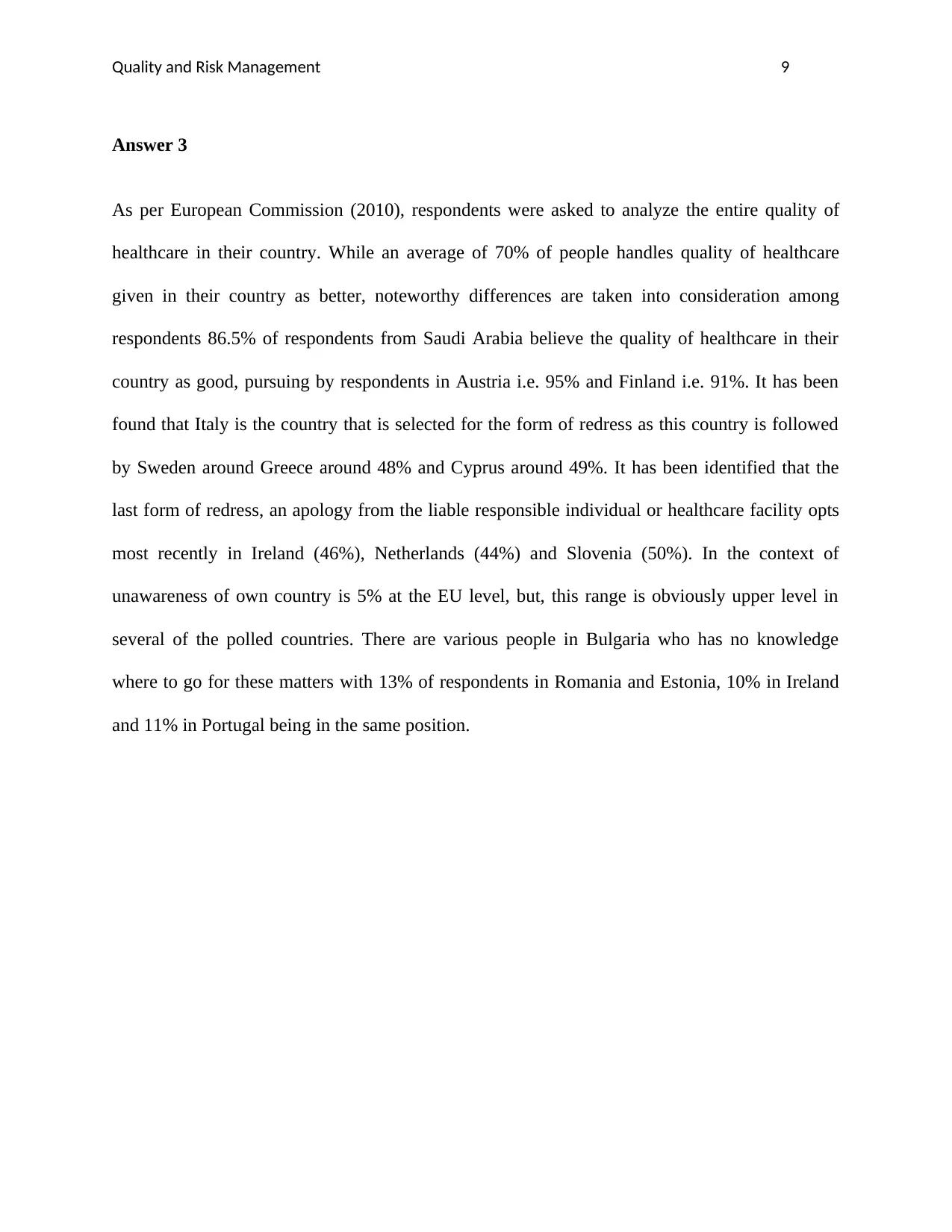
Quality and Risk Management 9
Answer 3
As per European Commission (2010), respondents were asked to analyze the entire quality of
healthcare in their country. While an average of 70% of people handles quality of healthcare
given in their country as better, noteworthy differences are taken into consideration among
respondents 86.5% of respondents from Saudi Arabia believe the quality of healthcare in their
country as good, pursuing by respondents in Austria i.e. 95% and Finland i.e. 91%. It has been
found that Italy is the country that is selected for the form of redress as this country is followed
by Sweden around Greece around 48% and Cyprus around 49%. It has been identified that the
last form of redress, an apology from the liable responsible individual or healthcare facility opts
most recently in Ireland (46%), Netherlands (44%) and Slovenia (50%). In the context of
unawareness of own country is 5% at the EU level, but, this range is obviously upper level in
several of the polled countries. There are various people in Bulgaria who has no knowledge
where to go for these matters with 13% of respondents in Romania and Estonia, 10% in Ireland
and 11% in Portugal being in the same position.
Answer 3
As per European Commission (2010), respondents were asked to analyze the entire quality of
healthcare in their country. While an average of 70% of people handles quality of healthcare
given in their country as better, noteworthy differences are taken into consideration among
respondents 86.5% of respondents from Saudi Arabia believe the quality of healthcare in their
country as good, pursuing by respondents in Austria i.e. 95% and Finland i.e. 91%. It has been
found that Italy is the country that is selected for the form of redress as this country is followed
by Sweden around Greece around 48% and Cyprus around 49%. It has been identified that the
last form of redress, an apology from the liable responsible individual or healthcare facility opts
most recently in Ireland (46%), Netherlands (44%) and Slovenia (50%). In the context of
unawareness of own country is 5% at the EU level, but, this range is obviously upper level in
several of the polled countries. There are various people in Bulgaria who has no knowledge
where to go for these matters with 13% of respondents in Romania and Estonia, 10% in Ireland
and 11% in Portugal being in the same position.
⊘ This is a preview!⊘
Do you want full access?
Subscribe today to unlock all pages.

Trusted by 1+ million students worldwide
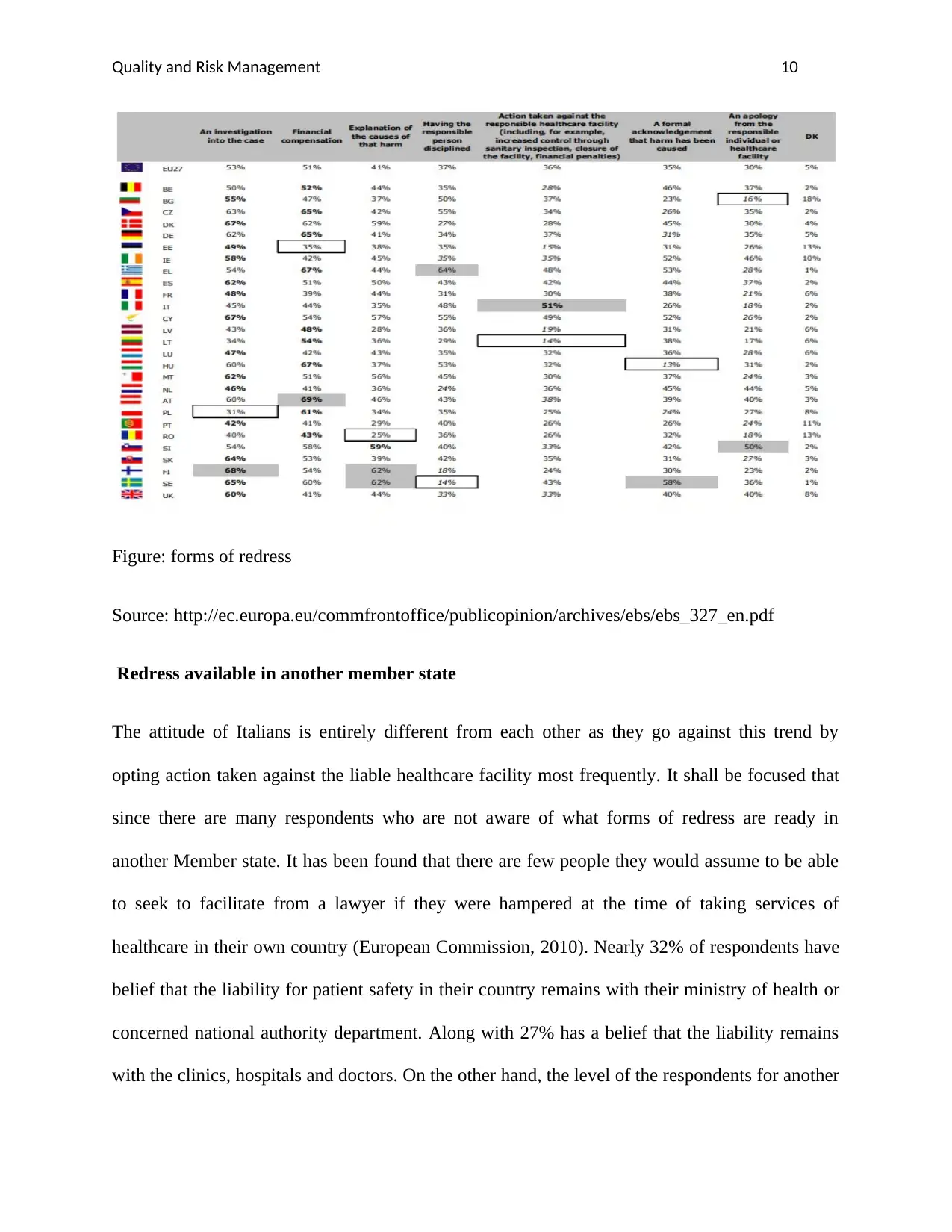
Quality and Risk Management 10
Figure: forms of redress
Source: http://ec.europa.eu/commfrontoffice/publicopinion/archives/ebs/ebs_327_en.pdf
Redress available in another member state
The attitude of Italians is entirely different from each other as they go against this trend by
opting action taken against the liable healthcare facility most frequently. It shall be focused that
since there are many respondents who are not aware of what forms of redress are ready in
another Member state. It has been found that there are few people they would assume to be able
to seek to facilitate from a lawyer if they were hampered at the time of taking services of
healthcare in their own country (European Commission, 2010). Nearly 32% of respondents have
belief that the liability for patient safety in their country remains with their ministry of health or
concerned national authority department. Along with 27% has a belief that the liability remains
with the clinics, hospitals and doctors. On the other hand, the level of the respondents for another
Figure: forms of redress
Source: http://ec.europa.eu/commfrontoffice/publicopinion/archives/ebs/ebs_327_en.pdf
Redress available in another member state
The attitude of Italians is entirely different from each other as they go against this trend by
opting action taken against the liable healthcare facility most frequently. It shall be focused that
since there are many respondents who are not aware of what forms of redress are ready in
another Member state. It has been found that there are few people they would assume to be able
to seek to facilitate from a lawyer if they were hampered at the time of taking services of
healthcare in their own country (European Commission, 2010). Nearly 32% of respondents have
belief that the liability for patient safety in their country remains with their ministry of health or
concerned national authority department. Along with 27% has a belief that the liability remains
with the clinics, hospitals and doctors. On the other hand, the level of the respondents for another
Paraphrase This Document
Need a fresh take? Get an instant paraphrase of this document with our AI Paraphraser
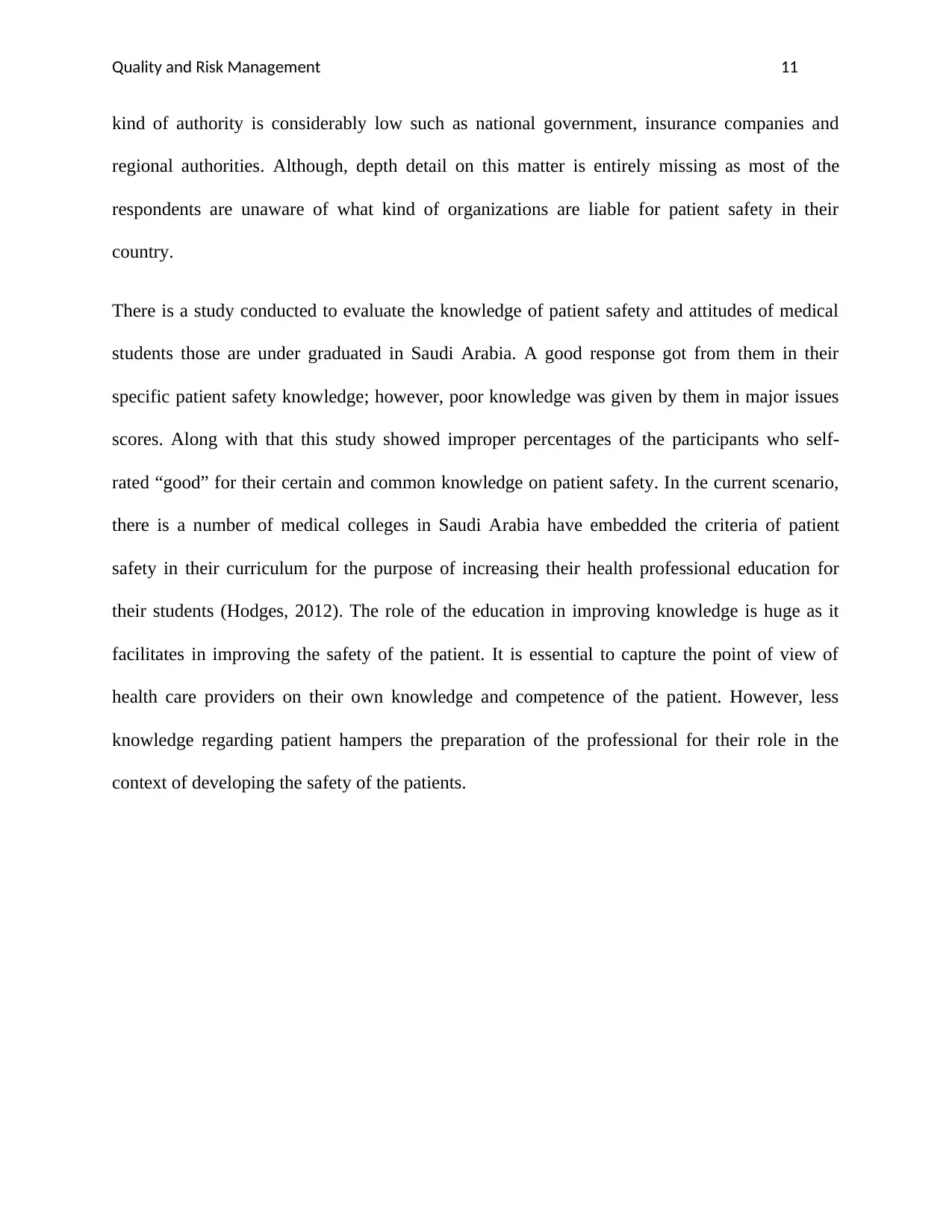
Quality and Risk Management 11
kind of authority is considerably low such as national government, insurance companies and
regional authorities. Although, depth detail on this matter is entirely missing as most of the
respondents are unaware of what kind of organizations are liable for patient safety in their
country.
There is a study conducted to evaluate the knowledge of patient safety and attitudes of medical
students those are under graduated in Saudi Arabia. A good response got from them in their
specific patient safety knowledge; however, poor knowledge was given by them in major issues
scores. Along with that this study showed improper percentages of the participants who self-
rated “good” for their certain and common knowledge on patient safety. In the current scenario,
there is a number of medical colleges in Saudi Arabia have embedded the criteria of patient
safety in their curriculum for the purpose of increasing their health professional education for
their students (Hodges, 2012). The role of the education in improving knowledge is huge as it
facilitates in improving the safety of the patient. It is essential to capture the point of view of
health care providers on their own knowledge and competence of the patient. However, less
knowledge regarding patient hampers the preparation of the professional for their role in the
context of developing the safety of the patients.
kind of authority is considerably low such as national government, insurance companies and
regional authorities. Although, depth detail on this matter is entirely missing as most of the
respondents are unaware of what kind of organizations are liable for patient safety in their
country.
There is a study conducted to evaluate the knowledge of patient safety and attitudes of medical
students those are under graduated in Saudi Arabia. A good response got from them in their
specific patient safety knowledge; however, poor knowledge was given by them in major issues
scores. Along with that this study showed improper percentages of the participants who self-
rated “good” for their certain and common knowledge on patient safety. In the current scenario,
there is a number of medical colleges in Saudi Arabia have embedded the criteria of patient
safety in their curriculum for the purpose of increasing their health professional education for
their students (Hodges, 2012). The role of the education in improving knowledge is huge as it
facilitates in improving the safety of the patient. It is essential to capture the point of view of
health care providers on their own knowledge and competence of the patient. However, less
knowledge regarding patient hampers the preparation of the professional for their role in the
context of developing the safety of the patients.
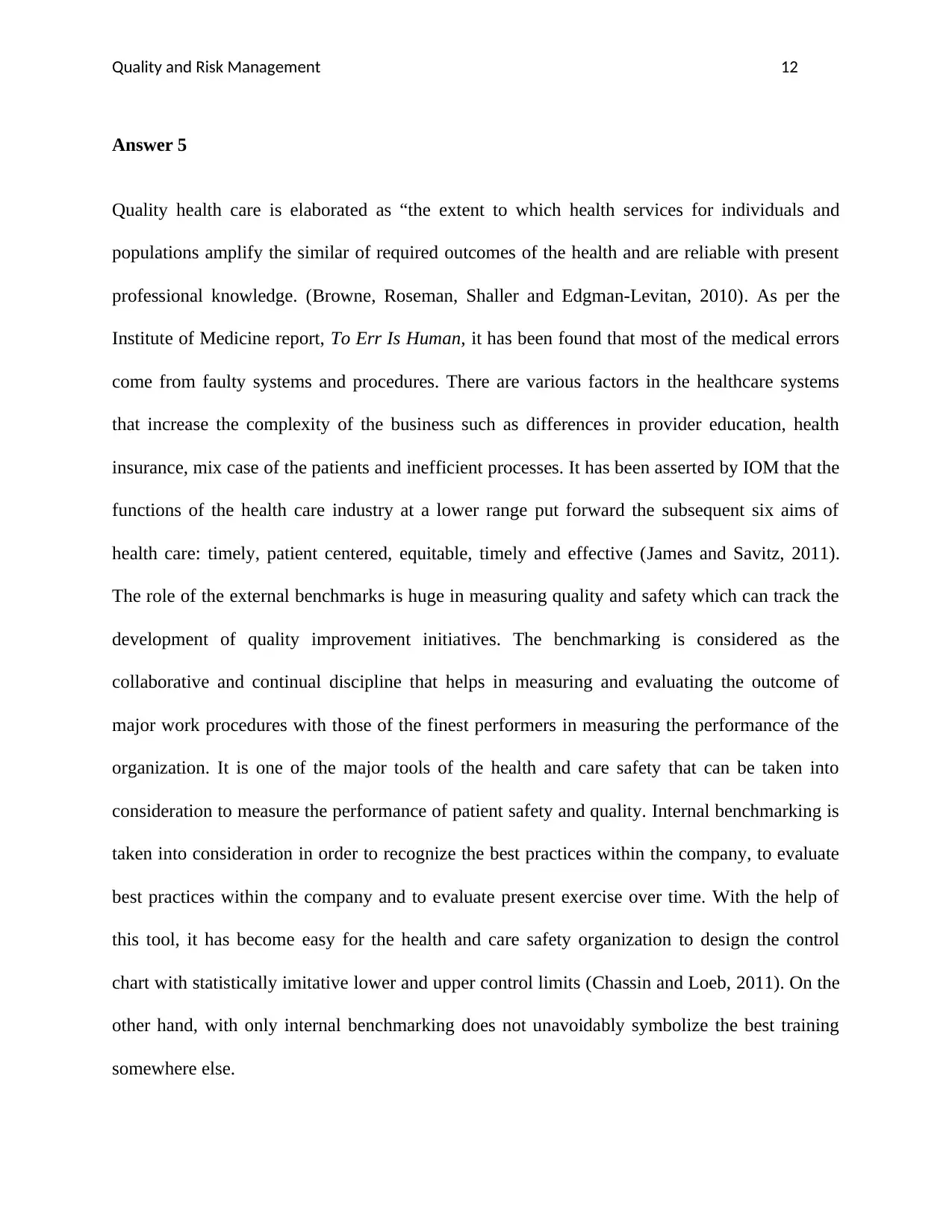
Quality and Risk Management 12
Answer 5
Quality health care is elaborated as “the extent to which health services for individuals and
populations amplify the similar of required outcomes of the health and are reliable with present
professional knowledge. (Browne, Roseman, Shaller and Edgman-Levitan, 2010). As per the
Institute of Medicine report, To Err Is Human, it has been found that most of the medical errors
come from faulty systems and procedures. There are various factors in the healthcare systems
that increase the complexity of the business such as differences in provider education, health
insurance, mix case of the patients and inefficient processes. It has been asserted by IOM that the
functions of the health care industry at a lower range put forward the subsequent six aims of
health care: timely, patient centered, equitable, timely and effective (James and Savitz, 2011).
The role of the external benchmarks is huge in measuring quality and safety which can track the
development of quality improvement initiatives. The benchmarking is considered as the
collaborative and continual discipline that helps in measuring and evaluating the outcome of
major work procedures with those of the finest performers in measuring the performance of the
organization. It is one of the major tools of the health and care safety that can be taken into
consideration to measure the performance of patient safety and quality. Internal benchmarking is
taken into consideration in order to recognize the best practices within the company, to evaluate
best practices within the company and to evaluate present exercise over time. With the help of
this tool, it has become easy for the health and care safety organization to design the control
chart with statistically imitative lower and upper control limits (Chassin and Loeb, 2011). On the
other hand, with only internal benchmarking does not unavoidably symbolize the best training
somewhere else.
Answer 5
Quality health care is elaborated as “the extent to which health services for individuals and
populations amplify the similar of required outcomes of the health and are reliable with present
professional knowledge. (Browne, Roseman, Shaller and Edgman-Levitan, 2010). As per the
Institute of Medicine report, To Err Is Human, it has been found that most of the medical errors
come from faulty systems and procedures. There are various factors in the healthcare systems
that increase the complexity of the business such as differences in provider education, health
insurance, mix case of the patients and inefficient processes. It has been asserted by IOM that the
functions of the health care industry at a lower range put forward the subsequent six aims of
health care: timely, patient centered, equitable, timely and effective (James and Savitz, 2011).
The role of the external benchmarks is huge in measuring quality and safety which can track the
development of quality improvement initiatives. The benchmarking is considered as the
collaborative and continual discipline that helps in measuring and evaluating the outcome of
major work procedures with those of the finest performers in measuring the performance of the
organization. It is one of the major tools of the health and care safety that can be taken into
consideration to measure the performance of patient safety and quality. Internal benchmarking is
taken into consideration in order to recognize the best practices within the company, to evaluate
best practices within the company and to evaluate present exercise over time. With the help of
this tool, it has become easy for the health and care safety organization to design the control
chart with statistically imitative lower and upper control limits (Chassin and Loeb, 2011). On the
other hand, with only internal benchmarking does not unavoidably symbolize the best training
somewhere else.
⊘ This is a preview!⊘
Do you want full access?
Subscribe today to unlock all pages.

Trusted by 1+ million students worldwide
1 out of 22
Related Documents
Your All-in-One AI-Powered Toolkit for Academic Success.
+13062052269
info@desklib.com
Available 24*7 on WhatsApp / Email
![[object Object]](/_next/static/media/star-bottom.7253800d.svg)
Unlock your academic potential
Copyright © 2020–2025 A2Z Services. All Rights Reserved. Developed and managed by ZUCOL.




